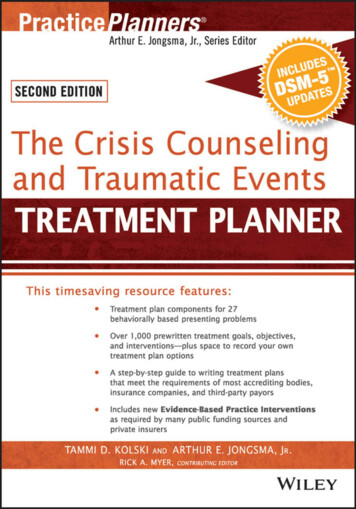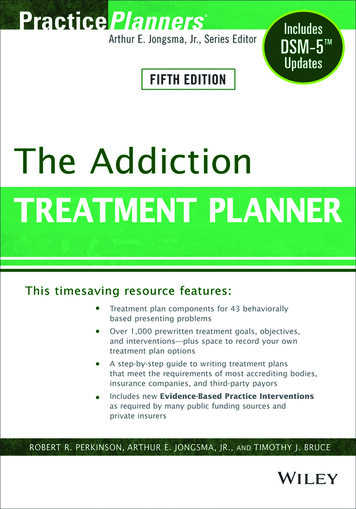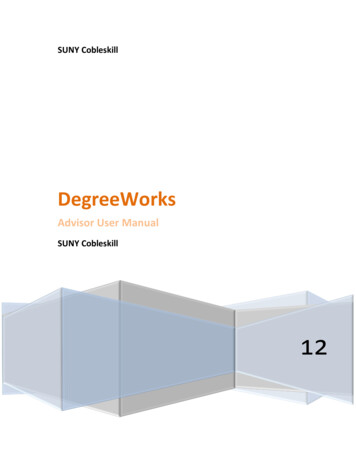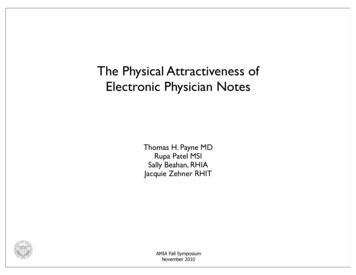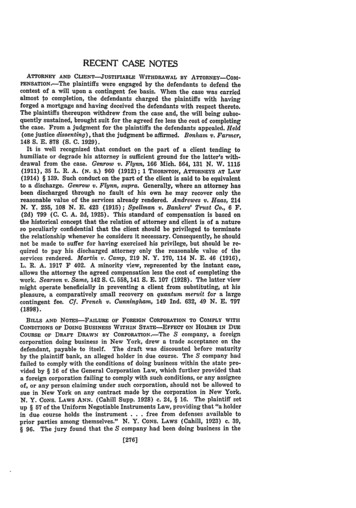
Transcription
RECENT CASE NOTESATTORNEY AND CLIENT-JUSTIFIABLE WITHDRAWAL BY ATTORNEY-COM-PENSATION.-The plaintiffs were engaged by the defendants to defend thecontest of a will upon a contingent fee basis. When the case was carriedalmost to completion, the defendants charged the plaintiffs with havingforged a mortgage and having deceived the defendants with respect thereto.The plaintiffs thereupon withdrew from the case and, the will being subsequently sustained, brought suit for the agreed fee less the cost of completingthe case. From a judgment for the plaintiffs the defendants appealed. Hold(one justice dissenting), that the judgment be affirmed. Bonham v. Farmer,148 S. E. 878 (S. C. 1929).It is well recognized that conduct on the part of a client tending tohumiliate or degrade his attorney is sufficient ground for the latter's withdrawal from the case. Genro;w v. Flynn, 166 Mich. 564, 131 N. W. 1115(1911), 35 L. R. A. (N. s.) 960 (1912); 1 THORNTON, ATTORNEYS AT LAW(1914) § 139. Such conduct on the part of the client is said to be equivalentto a discharge. Genrow v. Flynn, supra. Generally, where an attorney hasbeen discharged through no fault of his own he may recover only thereasonable value of the services already rendered. Andrewes v. Haas, 214N. Y. 255, 108 N. E. 423 (1915); Spellman v. Bankers' Trust Co., 6 F.(2d) 799 (C. C. A. 2d, 1925). This standard of compensation is based onthe historical concept that the relation of attorney and client is of a natureso peculiarly confidential that the client should be privileged to terminatethe relationship whenever he considers it necessary. Consequently, he shouldnot be made to suffer for having exercised his privilege, but should be required to pay his discharged attorney only the reasonable value of theservices rendered. Martin r. Camp, 219 N. Y. 170, 114 N. E. 46 (1916),L. R. A. 1917 F 402. A minority view, represented by the instant case,allows the attorney the agreed compensation less the cost of completing thework. Searson v. Sams, 142 S. C. 558,141 S. E. 107 (1928). The latter viewmight operate beneficially in preventing a client from substituting, at hispleasure, a comparatively small recovery on quantum meruit for a largecontingent fee. Cf. French v. Cunningham, 149 Ind. 632, 49 N. E. 797(1898).BILLS AND NOTES-FAILURE OF FOREIGN CORPORATION TO COMPLY WITHCONDITIONS OF DOING BUSINESS WITHIN STATE-EFFECT ON HOLDER IN DUECOURSE OF DRAFT DRAWN BY CORPORATION.-The S company, a foreigncorporation doing business in New York, drew a trade acceptance on thedefendant, payable to itself. The draft was discounted before maturityby the plaintiff bank, an alleged holder in due course. The S company hadfailed to comply with the conditions of doing business within the state provided by § 16 of the General Corporation Law, which further provided thata foreign corporation failing to comply with such conditions, or any assigneeof, or any person claiming under such corporation, should not be allowed tosue in New York on any contract made by the corporation in New York.N. Y. CONS. LAWS ANN. (Cahill Supp. 1928) c. 24, § 16. The plaintiff setup § 57 of the Uniform Negotiable Instruments Law, providing that "a holderin due course holds the instrument . . . free from defenses available toprior parties among themselves." N. Y. CONS. LAWS (Cahill, 1923) c. 39,§ 96. The jury found that the S company had been doing business in the[276]
19291RECENT CASE NOTESstate within the meaning of the General Corporation Law and returned averdict for the defendant, which the plaintiff moved to set aside. Hc,that the motion be granted. Allison Hill Trust Co. v. Sarandrea,236 N. Y.Supp. 265 (Sup. Ct 1929).In most states there are statutes limiting the enforcement of contractsmade by foreign corporations doing business within the state be-fore complying with specified requirements. Where the statute merely provides thatthe non-complying corporation shall not maintain an action on the contractin the courts of that state, such a statute is held to be unavailable as a defense to the drawee of a bill of exchange drawn by such corporation orto the maker of a promissory note payable to the corporation in a suitbrought by a holder in due course. McMann v. Walkor, 31 Colo. 261, 72Pac. 1055 (1903); Edwards v. Hambly FrdtProducts Co, 133 Tenn. 142,180 S. W. 163 (1915). But where such statutes declare contracts of thecorporation to be "void," such negotiable instruments have been held to beunenforceable against the drawee or maker by a holder in due course.Jones v. Martin, 15 Ala. App. 675, 74 So. 761 (1917); ALA. CODE (1928)§ 7220; ARIz. REv. STAT. (1913) par. 2228. Where, as in six states, thestatutes declare the contracts to be "void" as to the corporation and its"assignees," a holder in due course is allowed to recover against thedrawee or maker. National Bank of Commerce v. PicT 13 N. D. 74, 90N. W. 63 (1904) ; Commercial National Bank v. Jordan,71 Fla. 566, 71 So.760 (1916); CAL. GEN. LAws (Deering, 1923) act 1743, § 1; FLA. GEN.LAws (Skillman, 1927) § 6029; N. D. CouIP. LAws ANN. (1913) § 5242;OHIO GEN. CODE (Page, 1926) § 5508; S. D. REv. CODE (1919) § 8909; Wis.STAT. (1927) 226.02. The statutes of only five states expressly deny muitto both "assignees" of and persons "claiming under" the corporation.IOWA CODE (1927) § 8427; N. Y. CONS. LAWS, supra; R. I. GEN. LAWS(1923) § 3532; UTAH COMP. STAT. (1917) par. 947 (352); VT. GE. LAWS(1917) § 5009. Only in Utah has this clause been interpretcd with reference to § 57 of the Uniform Negotiable Instruments Law, where, upon similar facts, the court reached a decision contrary to that of the instant case.First National Bank v. Parker, 57 Utah 290, 194 Pac. 661 (1920). TheUtah court applied the mechanical rule of preference according to order ofenactment, concluding that the two statutes were irreconcilable. The instant court, on the other hand, probably influenced by a more stronglycommercial environment and tradition, sought a solution of the problemin considerations of commercial policy, and seems to have reached a moresatisfactory result.BiLLS ANNOrES-FAMURE OF HOLDER TO PRESENT FOR PAYMENT NOTEPAYABLE AT SPECIFIED BAN-EPECT OF SUBSEQUENT INSOLVENCY OF BANI.-The defendants executed to the B bank their note payable at the bankdnd containing a provision that, upon maturity, the bank could apply towardpayment of the note any of the maker's funds in the bank. Demand andpresentment were waived. The B bank indorsed this note to the C CreditCo., which in turn indorsed it to the plaintiffs. At maturity the defendantshad on deposit at the B bank sufficient funds to meet the note, and shortlythereafter sent a check in payment thereof, which the bank received andcharged to their account. No remittance was made to the holders, whomade no demand for payment until after the failure of the B bank. Thisaction was then brought. From a verdict for the plaintiffs for the principalsum without interest or costs, the defendants appealed. Held, that thejudgment be affirmed. Federal Intermediate Credit Bank v. Epstin, 148S. E. 713 (S. C. 1929).The instant case expressly overrules National Banhing Ass'n v. Zorm
278YALE LAW JOURNAL[Vol. 3914 S. C. 444 (1881), heretofore the leading minority case. The majorityview, to which this court now conforms, is that the failure of the holderto present a note payable at a specified bank does not preclude recoveryfrom the maker even though the latter, at maturity, had on deposit in thepayor bank sufficient funds to meet it, which were lost through failure ofthe bank. Binghampton Pharmacy v. First National Bank, 131 Tenn. 711,176 S. W. 1038 (1915); Moore v. Altem, 196 Ala. 158, 71 So. 681 (1916).This rule prevailed prior to the Negotiable Instruments Law and has beenmore widely followed since its adoption. Note (1919) 2 A. L. R. 1381. Thereasoning used to attain this result varies. Some courts seize upon thepoint that the maker of a note is primarily liable upon it and, by stressingthe provision in § 70 of the Negotiable Instruments Law, that "presentmentfor payment is not necessary to charge" such a party, reach the conclusion that the risks involved in late presentment are on the maker. Binghampton Pharmacy v. Firdt National Bank, supra. But cf. Northern Lumber Co. v. Clausen, 201 Iowa 701, 208 N. W. 72 (1926) (failure to presenta check within reasonable time held to discharge maker to extent of losscaused by the delay);NEGOTAB LE INSTRUMENTS LAW§ 186. Other courtsconsider that the payor bank is the agent of the maker in receiving orholding his funds and that therefore he must bear any loss caused by failureof the bank. First National Bank of Omaha v. Chilvon, 45 Neb. 257, 63 N.W. 362 (1895) ; Bartel v. Brown, 104 Wis. 493, 80 N. W. 801 (1899). Thusthe deposit of the maker does not constitute payment of the note but merelytender which he may plead in exoneration of interest and costs. See Adamsv. Hackensack Improvement Com., 44 N. J. L. 638, 647 (1882); cf. NEGOTIABLE INSTRUMENTS LAW§ 70. But, where the holder has forwarded the noteto the bank at which it is payable and at which the maker has sufficientfunds on deposit, and the bank delays in effecting payment, the holder mustbear the risk of failure of the bank. Baldwin's Bank of Penn Yan v.Smith, 215 N. Y. 76, 109 N. E. 138 (1915); Scott County Milling Co. v.Weems, 19 S. W. (2d) 1027 (Ark. 1929). Thus the more diligent holder,forwarding his note, is actually in a worse position than the one who neglects to make presentment until after the failure of the bank. It is submitted that § 70 is intended to control the allegations and defenses of thepleadings and that it is a misuse of that section to hold the holder to noduty whatever to make presentment. While checks and notes obviouslydiffer in many ways and while § 186 of the Negotiable Instruments Lawexpressly imposes a duty upon the holder of a check to make presentmentwithin a reasonable time, it does not necessarily follow that the holder ofa note is under no such duty. Such a requirement, if imposed, would shiftat least part of the risk from the maker who has provided funds sufficientfor payment to the holder without whose unreasonable delay no loss wouldhave been sustained.'csS-FALURE OF APPELLATE JUSTICESCONSTITuTIoNAL LAw-Dun PTo READ REcoRD.-After thorough oral argument by counsel, the SupremeCourt of Oklahoma decided a case by a five to four vote. The unsuccessful party subsequently sought an injunction in the federal courtrestraining enforcement of the judgment, on the ground that four of thefive concurring justices had not read the record and that their decisiontherefore violated the "due process" clause of the Fourteenth Amendment.The injunction was denied. Held, on appeal, that the order be affirmed.Owens v. Battenfield, 33 F. (2d) 753 (C. C. A. 8th, 1929).It is well settled that a merely erroneous decision of a state court doesnot constitute a denial of due process. Iowa Central Ry. v. Iowa, 160 U.S. 389, 16 Sup. Ct. 344 (1896); Bonner v. Gorman, 213 U. S. 86, 29 Sup.
1929]RECENT CASE NOTESCt. 483 (1909). Nor is a decision subject to attack merely because reachedwith rapidity. Tang Tun v. Edsell, 223 U. S. 673, 32 Sup. Ct. 359 (1912)(decision by Secretary of Commerce and Labor). But an arbitrary orcapricious decision, or one based on a very gross error, might violate theFourteenth Amendment. See Chicago, B. & Q. R. R. v. Chicago, 166 U. S.226, 17 Sup. Ct. 581 (1897) ; Thomas v. Texas, 212 U. S. 278, 281, 29 Sup.Ct. 393 (1909); American Ry. Exp. Co. v. Kentucky, 273 U. S. 269, 273,47 Sup. Ct. 353, 355 (.1927); Schofield, Federal Supreme Court andState Law (1908) 3 "L. Rnv. 195. And due process, of course, requiresa mentally competent tribunal. See Jordan v. Massachsetts, 225 U. S.167, 32 Sup. Ct. 651 (1912). A trial before a judge who has a direct, personal, and substantial pecuniary interest in the result is not due procec .Tumey v. Ohio, 273 U. S. 510, 47 Sup. Ct. 437 (1927); Note (1927) 40HARv.L. Rv. 1149; (1927) 36 YAxs- L. J.1171. An exception to thin ruleis sometimes made, however, when there is no other judge not equally disqualified. Evans v. Gore, 253 U. S. 245, 40 Sup. Ct. 550 (1920). Nor willa judge be disqualified when his pecuniary interest is remote and insignificant. Foreman -v. Marianna,43 Ark. 324 (1884) ; 2 COoLEY, CONSrrruIoNALLImITATIONS (8th ed. 1927) 872. Personal bias may disqualify a judge.Berger v. United States, 255 U. S. 22, 41 Sup. Ct. 230 (1921) (disqualifiedby statute); Ez parte Cornwell, 144 Ala. 497, 39 So. 354 (1905); Note(1921) 21 COL. L. Rv. 387. It has been suggested, however, that a decisionby a judge so disqualified would not necessarily violate due process. SeeTumey v. Ohio, supra at 523, 47 Sup. Ct. at 441. But see Jordan v. Massachusetts, supraat 176, 32 Sup. Ct. at 652. A trial before a court dominatedby a mob is not due process. Moore v,. Dempsey, 261 U. S. 86, 43 Sup. Ct.265 (1923); cf. Frank v. Mangum, 237 U. S. 309, 35 Sup. Ct. 582 (1915);(1923) 33 YALE L. J. 82. Nor is a proceeding before a court actuated byfraudulent motives. See-Chicago, B. & Q. Ry. v. Bibcock, 204 U. S. 585,27 Sup. Ct. 326 (1907); 3 WILLOUGMBY, THE CONsTrrtrroN (2d ed. 1929)§ 1125. Due process is not denied where the opinion is written by a judgewho has not heard the oral argument, or even where the whole court declinesto hear oral argument. Wagner Electric Mfg. Co. v. Lyndon, 2G2 U. S. 226,43 Sup. Ct. 589 (1923) ; Schmidt v. Boyle, 54 Neb. 387, 74 N. W. 964 (1898).It would seem that a decision should not be open to collateral attack underthe Fourteenth Amendment unless there is clear and substantial evidencethat the case was not given fair consideration. Any other rule would beimpracticable, for it would expose nearly every decision to collateral attack.See Chicago, B. & Q. Ry. v. Babcock, supra at 593-596, 27 Sup. Ct. at 327328; Morley v. Lake Shore Ry., 146 U. S. 162, 171, 13 Sup. Ct. 54, 58 (1892).There was no such evidence in the instant case. This conclusion is fortified by the fact that the record in any given case is rarely read by all themembers of the court. See (1925) 9 J. Am. JuD. SoC. 50 et seq.CONSTITUTIONAL LAw-FEDERAL TAXATION OF STATE INsauuIrrrE-TAXATION OF STATE BANK.-The plaintiff state duly organized the Bankof North Dakota, purchasing all of the capital stock for itself. The bankpaid, under protest, to the defendant federal revenue collector a capitalstock tax as provided by a federal statute. 40 STAT. 1057 (1919), 42 STAT.227 (1921), 26 U. S. C. § 1262 (1926). In a suit to recover the amount ropaid on the ground that the tax was unconstitutional since imposed on astate instrumentality, the lower court decided in favor of the defendant.Held, on appeal, that the judgment be affirmed. State of North Dakota v.Olson, 33 F. (2d) 848 (C. C. A. 8th, 1929).The general principle that the state and federal governments should befree from iind- ;ntre ---nee from outside sources in the exerci,-" "-ir
280YALE LAW JOURNAL[Vol. 39governmental functions is applied to numerous situations. Thus, the government is not responsible for the torts of its agents committed in the performance of governmental functions unless it has assumed such responsibilityby constitutional or legislative enactment. Stephens v. Commissioners ofPalisades Interstate Park, 93 N. J. L. 500, 108 Atl. 645 (1919); State v.Sharp, 21 Ariz. 424, 189 Pac. 631 (1920); Smith v. State, 227 N. Y. 405,125 N. E. 841 (1920). And the instrumentalities of federal and state governments are each exempt from taxation by the. other. Collector v. Day,11 Wall. 113 (U. S. 1870) ; Frey v. Woodworth, 2 F. (2d) 725 (E. D. Mich.1924) (income of employee of street railway operated by city held not subject to federal income tax); Mercantile National Bank v. City of NewYork, 121 U. S. 138, 7 Sup. Ct. 826 (1887) (state bonds held exempt fromfederal taxation); Farmers' and Mechanics' Savings Bank v. Minnesota,232 U. S. 516, 34 Sup. Ct. 354 (1914) (federal bonds held non-taxable bystate); see Cohen and Dayton, Federaland State Taxation (1925) 34 YALEL. J. 807, 821. Where a government carries on a private enterprise chieflyfor pecuniary profit, however, it is generally held that it loses its immunityto tort actions. Chafor v. Long Beach, 174 Cal. 478, 163 Pac. 670 (1917) ;Sloan Shipyards v. United States Shipping Board, 258 U. S. 549, 42 Sup.Ct. 386 (1922); Borchard, Government Liability in Tort (1924) 34 YAUL. J. 1, 24. It would seem reasonable to hold that it loses its immunity totaxation under the same circumstances. There is substantial agreementin holding the operation of gas, electric light and water works by the government to be subject to federal taxation as private functions. Flint v.Stone Tracy Co., 220 U. S. 107, 31 Sup. Ct. 342 (1910); see Note (1925) 38HARv. L. Rnv. 793, 795. And a state's dispensary for the sale of liquor haslikewise been held non-exempt. South Carolinav. United States, 199 U. S.437, 26 Sup. Ct. 110 (1905). Banking would seem to possess more of thecharacteristics of a private business than do public utilities or liquor dispensaries. Furthermore, if immunity to federal taxation were to be extendedto the type of activity involved in the instant case, it would seem reasonableto expect to find the various states assuming control over many other objectsof internal revenue, thereby depriving the national government of a valuable source of income. Cf. South Carolinav. United States, supra at 454, 26Sup. Ct. at 113 (1905).CONSTITUTIONAL LAW-WORKMEN'S COMPENSATION-REIMBURSEMIENT OFEMPLOYER BY THIRD PARTY WRONGDOER FOR PAYMENTS TO STATE FUND.-A New York statute provides that when an employee covered by the Workmen's Compensation Law is killed in the course of his employment, andno dependents claim under the act, the employer or his insurance carriershall pay 500 into each of two funds, one to rehabilitate men injured inindustry, and the other to provide extra compensation for men whose cecondpartial injury results in total incapacitation. N. Y. CONS. LAWS (Cahill,1923) c. 66, § 15 (8, 9). [The latter loss formerly fell on the employer orinsurance carrier concerned. See Matter of State Industrial Commissionv. Newman, 222 N. Y. 363, 366, 118 N. E. 794, 795 (1918)] It is furtherprovided that if the employee's death is due to the wrongful act of a thirdparty the employer or his insurance carrier may collect from this wrongdoer the 1000 that has been paid. N. Y. CONS. LAWS (Cahill, 1923) c. 66,§ 29. The defendant negligently killed an employee of the plaintiff, andsettled the widow's claim for 15,000, which was more than the averagefull compensation under the Compensation Law. Since this settlement leftno dependents to claim under the Compensation Law, the insurance carrierwas forced to pay 1000 to the aforesaid state funds, and now brings suitunder § 29 of the instant statute. On an agreed statement of facts the
19291RECENT CASE NOTESAppellate Division gave judgment for the plaintiff. Phoenix Indemnity Co.v. Staten Island Rapid Transit Ry., 224 App. Div. 346, 230 N. Y. Supp.747 (2d Dep't 1928). Held, on appeal (two judges dissenting), that thejudgment be affirmed. Phoenix Indemnity Co. v. Statcn Island Rapid Tra d4 ?yg, .251 N. Y. 127, 167 N. E. 194 (1929).The constitationality of such a provision as § 29 of the instant statutehas never before been passed upon by a court of final appeal Cf. Travelers' Ins. Co. v. Post, 128 Misc. 626 (Municipal Ct. 1927), appeal denied, 222N. Y. Supp. 913 (App. Div. 1st Dep't 1927); WIS. STAT. (1927) § 102. 29(3). In the present case judgment for the plaintiff was affirmed on theground that, since the insurance carrier was 1,000 poorer by reason of thedefendant's negligent act, the legislature acted within its powers in placingthis loss upon the wrongdoer. The dissent argues that the statute amountsto taking property without due process of law in that, having paid for alldamages caused by its negligent act, the defendant is now forced to payfor losses arising out of the operation of industry-lonses which do notconcern it as wrongdoer. See dissent in instant ease, supra at 198. Thetwo 500 payments exacted from the employer have been sustained on twogrounds: (1) that the payments were less than he would have had tomake had dependents claimed, and (2) that he could justly be made to payan occupation tax covering the risk of injuries necessarily occurring toemployees in his industry. Sheehan Co. v. Shuler, 265 U. S. 371,'44Sup. Ct. 548 (1923). Obviously, neither of these reasons is applicable tothe present situation. The arbitrary nature of the payment with respectto this defendant is partly revealed when it is considered that had thewidow claimed against the insurance carrier under the Compensation Law,the present defendant, though still paying full damages, -would have paid 1,000 less, since the 1,000 payment could not have been exacted fromthe employer's insurance carrier. See (1929) 29 CoL. L. REv. 1011. Itmay also be said that, in general, it is easier for the employer than for thethird party to insure himself against such additional loss. Finally, sincethis statute imposes the penalty only upon those tortfeasors who (1) kill(2) an employee (3) covered by the Workmen's Compensation Law (4)during the course of his employment, and (5) where no claim is made bydependents, it is urged that this places the defendant in an unjust and arbitrary classification, without reference to damage done or occupation pursued, and is therefore unconstitutional. Cf. People v. Beakcs Dairy Co.,222 N. Y. 416, 429, 119 N. E. 115, 119 (1918).CONTRACTS-PROMISOR'S OFTIONS-PROMISE TO PURCHASE ALL REqumEMENTS OF CONTEMPLATED BUSINESS-The defendant wholesale ice companyand the plaintiff coal company contracted that the former should for acertain period furnish the latter with all the ice it might sell up to onehundred tons daily. At the time of contracting, the plaintiff had no established business in ice but contemplated entering such business. The defendant later repudiated the contract and the plaintiff brought suit for damages.The lower court gave judgment for the plaintiff. Held, on appeal, that thecontract was void for lack of mutuality, since the plaintiff had no "actualrequirements" for ice. Judgment reversed. Nassau Supply Co. v. leoService Co., 234 N. Y. Supp. 656 (App. Div. 1st Dep't 1929).A promise to purchase all of one's requirements of a certain commodityis sufficient consideration for the return promise of the vendor to sell. 1WILLISTON, CONTRACTS (1st ed. 1920) § 140; Corbin, The Effect of Optionon Consideration (1925) 34 YAL L. J. 570, 531; Patterson, Illusory Promises and Promisors' Options (1920) 6 IowA L. BULL. 209, 224. But something more than the satisfaction of formal consideration seems required
YALE LAW JOURNAL[Vol. 39to meet the defense of "lack of mutuality." Where the prospective demandof the vendee is fairly stable, as in the case of business consumers or manufacturers, the contract is usually held enforceable. Rosenthal v. EmpireBrick and Supply Co., 123 App. Div. 503, 108 N. Y. Supp. 347 (1st Dep't1908); Marx v. American Malting Co., 169 Fed. 582 (C. C. A. 6th, 1909);But whereScott v. Stevenson Co., 130 Minn. 151, 153 N. W. 316 (1915).the prospective demand is very elastic, as where the buyer is a jobber ordealer, there seems to be considerable difference of opinion as to the validityof the agreement. Cf. Crane v. Crane, 105 Fed. 869 (C. C. A. 7th, 1901)(agreement said to be unenforceable where seller agreed to furnish all thedock-oak lumber the buyers would require for their trade in the Chicagomarket for a certain year); Ehrenworth v. Stuhmer, 229 N. Y. 210, 128N. E. 108 (1920) (agreement held enforceable where defendant agreed tosell all the bread the plaintiff would require upon his route). See Note(1927) 27 COL. L. REV. 178. The courts, in interpreting the quantity term ofthe contract, seem to fear that "requirements" may set no definite limiton the amount that may be ordered, thus leaving the seller at the mercyof the buyer who orders an exhorbitant amount. But the term "requirement," while not restricted to average needs over a prior period, is subjectto a maximum limitation gauged by reasonable expectations. .E. G. DaileyCo. v. Clark Can Co., 128 Mich. 591, 87 N. W. 761 (1901); N. Y. CentralIron Works Co. v. United States Radiator Co., 174 N. Y. 331, 66 N. E.967 (1903). But cf. Jenkins and Co. v. Anaheim Sugar Co., 247 Fed. 958(C. C. A. 9th, 1918). In many cases where such agreements have beendeclared to be unenforceable, the buyer had already received all to which hewas reasonably entitled and was trying to recover for failure to fill excessiveorders. Cf. Crane v. Crane, supra; Schl, gel Mfg. Co. v. Cooper's Glue Factory, 231 N. Y. 459, 132 N. E. 148 (1921). Under facts similar to those inthe instant case, recovery has been allowed. Texas Co. v. PensacolaMaritime Corp., 279 Fed. 19 (C. C. A. 5th, 1922) (ship-coal dealer extendingbusiness to sale of bunker oil; express maximum limit set on amount thatmight be ordered). But cf. American Trading Co. v. National Fibre andInsul. Co., 31 Del. 258, 114 Atl. 67 (1921) (recovery denied where purchaser ordered excessive amount, no limit being set in the contract). Thedecisions in these cases seem to depend on the limitation of the buyer'srequirements. In the instant case, the actual needs of a contemplated icebusiness and the fixed makimum should have provided a sufficient limitation.EVEDENCE-ADMISSIBILITY OF STATEMENTS TO PHYSICIANPHYSICIAN'S OPINION.-The plaintiff brought an action toAS BASIS roRrecover for injuries suffered while riding in one of the defendant's cabs. Over the defendant's objection the trial court permitted a physician to read a historyof the case, consisting of statements made to him by the plaintiff regardingthe accident, her past suffering, and her present condition. The statementswere made at a consultation post litem motam, solely to qualify the physician as an expert witness. The plaintiff contended that the evidence wasadmissible as a basis for the physician's opinion. The trial court gavejudgment for the plaintiff. Held, on appeal (two justices dissenting), thatthe statements to the physician were erroneously admitted, but were notsufficiently prejudicial to warrant reversal. Reid v. Yellow Cab Co., 279Pac. 635 (Ore. 1929).There is a distinction, not always recognized, between the admission ofstatements by a patient to a physician to prove the truth of the matter,their admission to show the basis of the physician's opinion, and admissionof the opinion itself. 1 WIGMORE, EVIDENCE (1923) § 688; 3 ibid. § 1720.Where the statements are of present pains and symptoms, made with a
19291RECENT CASE NOTESview to obtaining treatment, they are admissible under an exception to thehearsay rule, on the theory that a patient seeling treatment vill notfalsify. Shearer v. Aurora E. & C. R. R., 200 IIl. App. 225 (1916); seaShaughnessy v. Holt, 236 Ill. 485, 86 NT. E. 256 (1908); (1926) 13 VA. L.REv. 133. But where the statements are made merely to qualify the physician as an expert witness, the reason for credibility is absent and thestatements are usually excluded. Consolidatcd Traction Co. v. Lambertson, 60 N. J.L. 452, 38 AtL 683 (1897); Shaughnessty v. Holt, supra; Note(1908)' 21 L. R. A. (N. s.) 826. A competent physician's opinion, basedon the patient's relation of his case history and on an examination forthe purpose of treatment, is generally admissible. Flcasher v. CardionPack. Co., 93 Wash. 48,160 Pac. 14 (1916); Ft.Smith & TV. Ry. v. Hutchinson, 71 Okla. 139, 175 Pac. 922 (1918). But where the opinion is basdentirely on the patient's statements it is inadmissible. GrandTrunk Pac.Ry.v. Tollard, 286 Fed. 676 (C. C. A. 8th, 1923); (1919) 29 YArzL L. 3. 232.Where the opinion is admitted, and the above three-fold distinction recognized, the courts will admit the patient's statement of his case history asa basis for the expert opinion. Croninv.Fitchburg Ry., 181 Mass. 202, 63N. E. 335 (1902); Johnson v. Electric Co., 125 Me. 88, 131 Atl. 1 (1925);Lowery v. Jones, 121 So. 704 (Ala. 1929). In the instant case the courtregarded the history of the case, as related by the plaintiff to the physician,as incompetent because it was given at a consultation post litem fiotam,and merely to qualify the physician as a witness. For these reasons theopinion itself might have been excluded. Hinz v. Wagner, 25 N. D. 110,140 N. W. 729 (1913); Texas & N. 0. R. R. v. Steplums, 198 S. W. 396(Tex. 1917). Contra: Chicago Ry. v. Jackson, 63 Okla. 32, 162 Pac. 823(1917). But once the opinion was admitted, the statements of the plaintiff,so far as they were relevant, might be admissible to show the basis of theopinion, even though not admissible as proof of their truth. 3 WIGMxonE, op.cit. supra § 1720.INSURANCE-APPUCANT'S MISSTATEMENT OF MATERIAL FACT-REQUIDEDIENT THAT MISREPRESENTATION BE FRAUDULENT TO CONsTru E DEFENSE.An applicant for a life insurance policy, when questioned by the company'smedical examiner concerning previous illness and medical attention, replied"Nothing except that you know of, doctor." The examiner wrote "None"on the application, although the applicant had been treated by him severaltimes. In an action on the policy, the lower court instructed the jury that,in the absence of fraud, a material misrepresentation in the applicationwould not preclude a finding for the plaintiff. A verdict was returnedfor the plaintiff. Held, on appeal, that the judgment be affirmed. Kuihns v.N. Y. Life Insurance Co., 147 Atl. 76 (Pa. 1929).It has long been held that any misstatement of a material fact in theapplication, whether innocently or fraudulently made, will avoid the policy.Campbell v. New England Mutual Life Insurance Co., 98 Mass. 381 (1867) ;Metropolitan Life Insurance Co. v. Feezko, 26 Ohio App. 287, 159 N. E.486 (1927); VANCE, INSURANCE (190
forged a mortgage and having deceived the defendants with respect thereto. The plaintiffs thereupon withdrew from the case and, the will being subse- . Spellman v. Bankers' Trust Co., 6 F. (2d) 799 (C. C. A. 2d, 1925). This standard of compensation is based on the historical concept that the relation of attorney and client is of a nature







